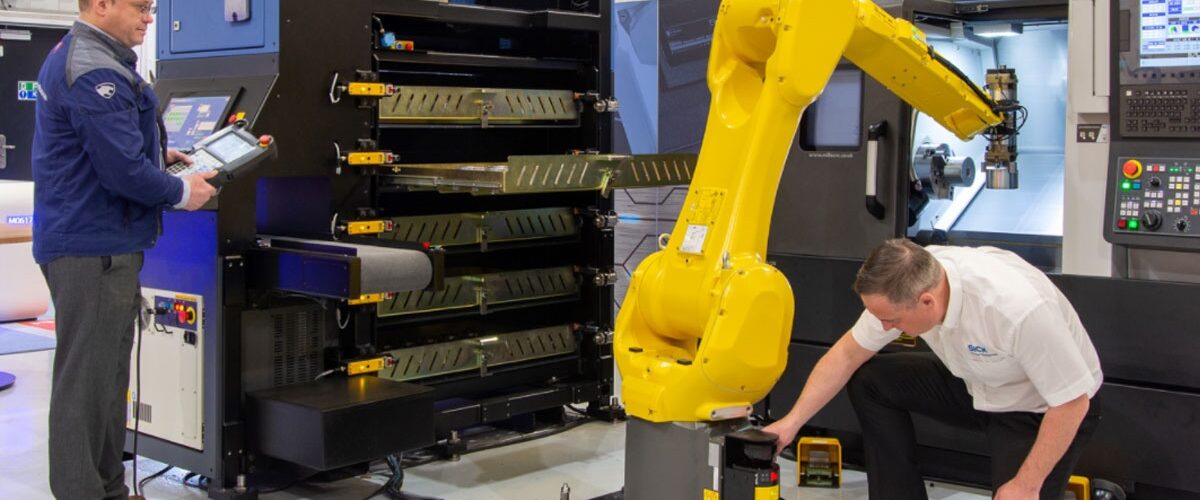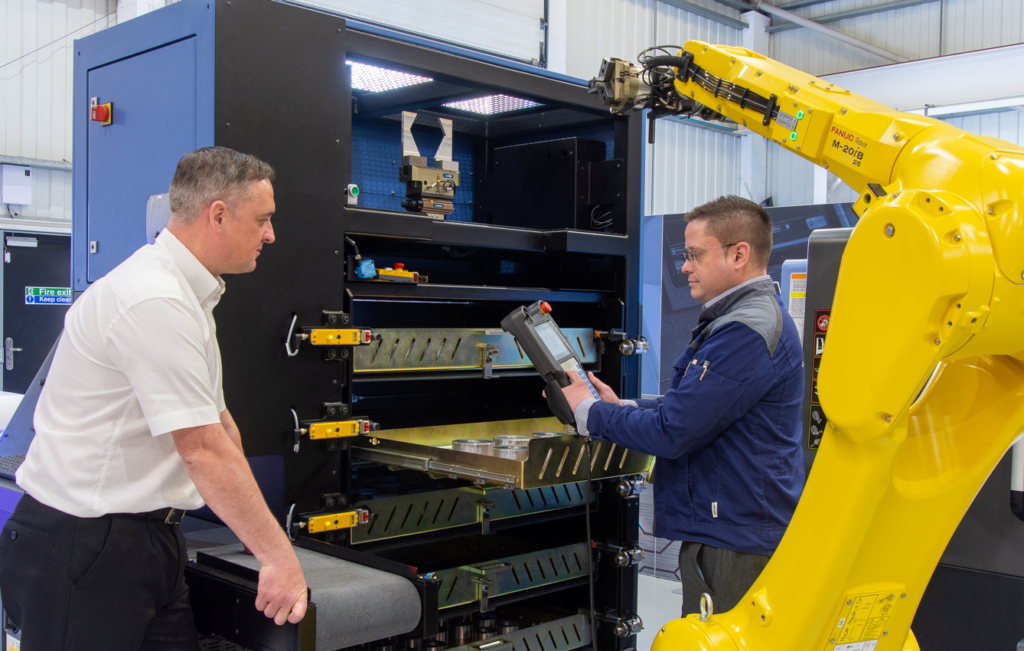How Mills CNC increased productivity with flexible robot cells
Flexible manufacturing cells are a cornerstone of Digital Transformation. They can revolutionize production halls by freeing them from conventional, fixed, often linear processes to enable shorter production runs, increased variety, and shorter delivery times. Deploying robots to tend the machines in a flexible cell relieves staff from heavy lifting or repetitive duties, can assure consistently high product quality, and enable 24/7 operation.
SICK safety products reduce downtime and save space for Mills CNC’s new range of innovative robotic flexible manufacturing cells. This myth-busting project presents a masterclass in safety through productivity. But on their journey to Digital Transformation, many manufacturers are instinctively cautious about integrating flexible cells into their production workflows: Can I find the extra space to accommodate the robot cell? Will constant e-stops reduce productivity and therefore make investment unviable? Will the integration be too complex, time-consuming, or costly?
Busting the myths
Many prospective customers bring these questions to the Warwickshire-based machine tool specialist Mills CNC. A leader in building machine cells with industrial robots, Mills CNC is busting these myths by delivering safe and efficient automatic robot systems to tend the Doosan lathes, milling machines and machining centers, for which it is the exclusive UK distributor.
For Mills CNC, integrating compliant machine safety into its flexible robotic machine cells could have been particularly challenging because, by nature, there is still a relatively high degree of human interaction required, explains Chris Ingham, Control and System Engineer for Mills CNC.
“Take our new SYNERGi Premier flexible robot cells, which have a two-way loading/unloading station with five automatic drawers,” he continues. “Even at this increased level of automation, operator involvement is inevitable to interact with the Fanuc robot that is continuously feeding the machine.
“Working outside the cell, operators load up workpieces and remove machined components through the two-way automatic drawers. Meanwhile, the robot operates continuously inside the cell, taking workpieces out of the drawers and feeding the machine, before replacing the machined component back into the drawer. Setters must enter the robot cell periodically to service the machine tool itself.
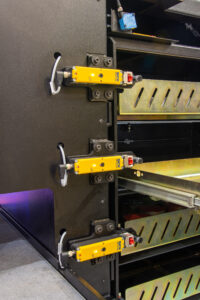 “With automatic machine tending systems, the key objective is to keep the robot going for production efficiency, while having the flexibility to change the parts in and out. Our custom HMI software allows you to load as many parts in the tray as you so wish, or run all five trays out in one go. It truly is a fully flexible solution.
“With automatic machine tending systems, the key objective is to keep the robot going for production efficiency, while having the flexibility to change the parts in and out. Our custom HMI software allows you to load as many parts in the tray as you so wish, or run all five trays out in one go. It truly is a fully flexible solution.
“You can then employ staff much more efficiently on the shop floor because operators and setters can be deployed across several cells, and perform other duties.”
Implementing safety was critical to bringing the whole range of SYNERGi flexible robot cells to market successfully, says Ingham. To protect and enhance the benefits of the flexible cell concept, the safety system had to minimize machine downtime and become second nature, almost invisible, to operators.
“Automation should never make life harder. It should always make it easier,” Ingham continues. “Our machine cells have to be adapted into our customers’ work practices without the technology being too expensive or complex.”
So, Mills CNC turned to machinery safety specialists at SICK, and together they worked to integrate safety systems that enable productivity and maximum uptime, while being completely transparent for the operating entity.
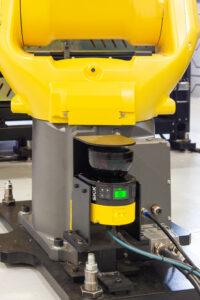 Safety was a game-changer
Safety was a game-changer
“Implementing SICK’s network safety has been a massive game-changer for us in bringing the machines to market,” says Ingham. “Less sophisticated systems would have required a complete shutdown whenever the robot and operator inhabited the same space, requiring a reset and restart. They would have also required complex wiring that could have been difficult, if not impossible, to implement.”
All Mills CNC’s automatic SYNERGi flexible manufacturing cells are fitted with the latest SICK sensor hardware. Each of the five automatic drawers of the SYNERGi Premier system is fitted with a SICK TR110 safety interlock with guard locking. A SICK microScan3 safety laser scanner is positioned at the foot of the robot to allow setters’ safe access into the machine cell.
The SICK EFI Pro network technology is the heart of the safety concept, supporting direct integration of SICK sensors and the robot controls via Ethernet/IPTM CIP SafetyTM up to SIL3/PLe.
“The number one challenge for us was finding a system that could talk natively, using the same protocols as the robot,” Ingham explains. “Without the direct connection through the SICK EFI-pro system over a single Ethernet cable, the integration would have been much more difficult, and more costly.
“The SICK TR110 interlock interacts directly with the Fanuc Dual Check Safety (DCS) control architecture of the robot cell system via CIP Safety. The DCS system enables me to draw 3-dimensional boxes around the drawer catches to restrict the movement of the robot and ensure clearance for the operator.”
The SICK Safe EFI-pro System is SICK’s safety network for industrial automation, based on the CIP Safety protocol. It enables safe communication between SICK EFI-pro devices like the microScan3, other SICK sensors, and third-party CIP-SafetyTM devices like robot controllers, through the SICK Flexi Soft safety controller and a SICK EFI-pro gateway. The SICK EFI-pro system also enables full remote diagnostics so that the system’s performance is recorded and monitored.
Mills CNC opted to use the 9-metre range microScan3 Core using SICK safeHDDM® multiple scanning technology on all their SYNERGi systems to control safe access for setters into the cell. The SICK safety system enables the scanner to be used as the primary safety device with two protective fields to slow the robot down before it enters a full stop.
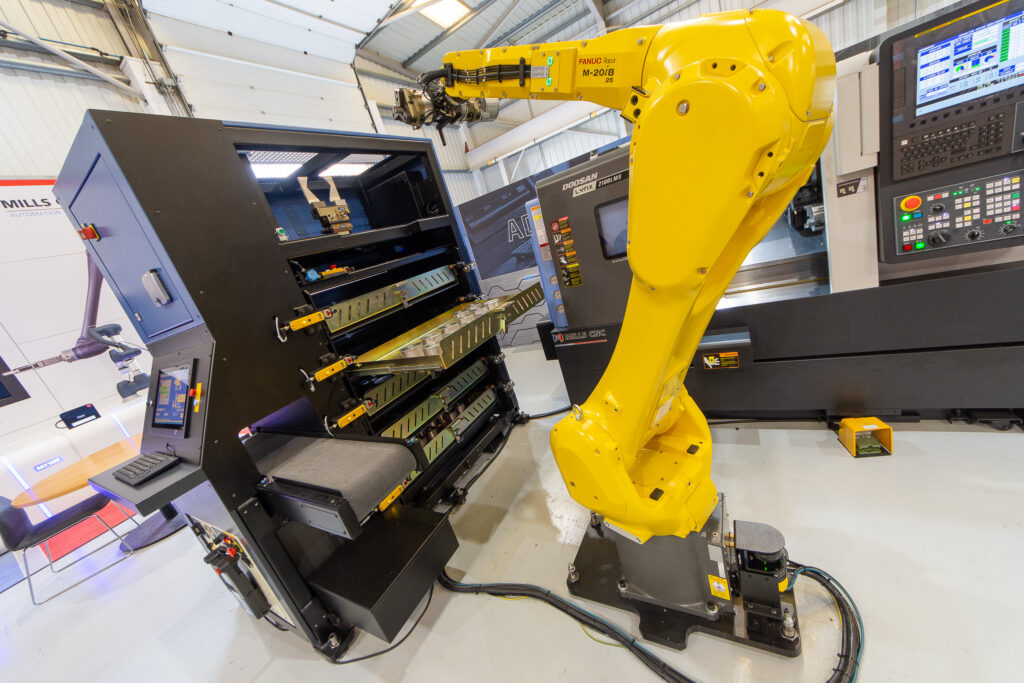
Floor space minimized
“Sometimes we have to shoehorn a machine into a very small footprint,” says Ingham. “With the microScan3, you can minimize the floor space. And by slowing the robot down and enabling continued operation, you are increasing productivity dramatically. The alternative would have been a fully enclosed cell and reduced uptime.
“Thanks to the SICK dynamic EFI-pro system, the fields can be set closer in to take up less floor space, and the robot can continue to operate safely for as long as possible, so maximum uptime is maintained.”
SICK UK’s National Machinery Safety Product Manager, Martin Kidman, explains: “For Mills CNC, the EFI Pro system is allowing safe collaboration between the Fanuc robot’s DCS and the TR110 interlocking concept to perform complex safety-rated logic functions on the machine to the required standards.
“It enables direct data transfer to the safety control of the robot over one Ethernet cable with no hard wiring. Without this, each safety function would increase the wire capacity exponentially. A complex system like this would need hundreds of wires, or could even be completely impossible.
“Downtime is the enemy of any production process. Mills CNC has demonstrated a masterclass in delivering productivity through safety in their new SYNERGi automatic manufacturing cells. With the benefit of the SICK safe EFI-pro dynamic network safety, we have been able to work in partnership to engineer a complex system from a safety point of view that achieves ease and simplicity with seamless integration for Mills CNC customers.”
Want to learn more about this topic?


